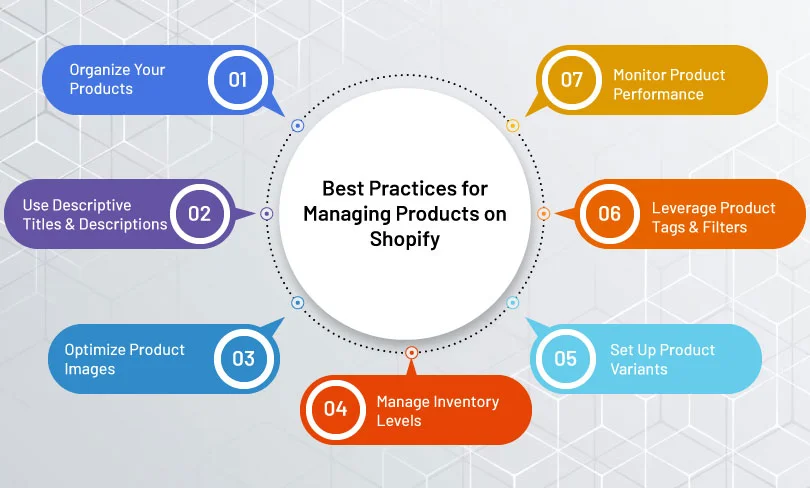7 Best Practices for Shopify Product Management

Managing products on Shopify can seem overwhelming, especially if you’re just starting your eCommerce journey. Whether you’re a small business owner or running a large online store, effective Shopify Product Management is key to providing a seamless shopping experience for your customers. But don’t worry! With the right practices in place, you can easily streamline your product catalog and keep everything running smoothly.
In this blog, we’ll walk you through seven best practices for managing your Shopify products like a pro. From organizing your inventory to setting up clear product descriptions, these tips will help you save time and make your store more efficient. Let’s dive into the strategies that can take your Shopify product management to the next level!
What is Shopify Product Management?
Shopify Product Management refers to the process of organizing, maintaining, and optimizing the products in your Shopify store. It involves everything from adding new products, managing inventory, and setting prices to updating product descriptions and images. Good product management ensures that your online store runs smoothly, offers a user-friendly experience, and helps customers easily find what they’re looking for.
It also includes categorizing products, setting up variants (like size or color), and managing product tags to improve search functionality. By effectively managing your products, you not only improve customer satisfaction but also boost sales by ensuring your store is easy to navigate and visually appealing.
Importance of Product Management in Shopify
Product management plays a vital role in the success of any Shopify store. A well-managed product catalog, paired with an effective Shopify Store Design, creates a seamless shopping experience, helping customers find what they need quickly and easily.
Market Research
Understanding customer needs and market trends to inform product decisions. This involves analyzing customer feedback, studying competitors, and staying updated with industry trends to ensure your products remain relevant and appealing.
Product Strategy
Developing a clear roadmap for product development and releases. This includes setting goals, defining product features, and planning the lifecycle of each product to align with your business objectives.
Inventory Management
Ensuring products are well-stocked and available to meet demand. Effective inventory management helps prevent stockouts and overstock situations, optimizing storage costs and improving customer satisfaction.
SEO Optimization
Enhancing product listings with keywords and descriptions to improve search engine rankings. This involves using relevant keywords, writing compelling product descriptions, and optimizing images to attract more organic traffic to your store.
Best Practices for Managing Products on Shopify

Managing your Shopify products efficiently is key to ensuring your online store runs smoothly, attracts customers, and drives sales. By implementing the following best practices, you can simplify operations and create a seamless shopping experience that keeps customers coming back.
Here are the 7 best practices for Shopify product management:
Organize Your Products
Group your products into clear, relevant categories or collections. This makes it easier for customers to browse, filter, and locate products, resulting in a smoother shopping experience.
Use Descriptive Titles & Descriptions
Provide clear, engaging, and informative product titles and descriptions. This helps customers understand the benefits and features of your products, encouraging them to make informed purchasing decisions.
Optimize Product Images
High-quality product images are essential for attracting customers. Use multiple images from different angles, ensure proper lighting, and display zoom-in features to showcase your products in the best light.
Manage Inventory Levels
Regularly update your inventory levels to avoid overselling or stockouts. Set up alerts for low-stock products and ensure your customers know when items are back in stock.
Set Up Product Variants
If your products come in different sizes, colors, or styles, set up variants. This gives customers more flexibility to choose the exact option they want, enhancing their shopping experience.
Leverage Product Tags & Filters
Use relevant product tags and filters to make it easier for customers to search and find specific items. Well-organized filters can significantly improve navigation and product discoverability.
Monitor Product Performance
Regularly analyze sales data to track the performance of each product. Identify your top sellers and underperforming items to adjust your strategy, restock popular items, and phase out less popular ones.
Conclusion
Implementing these 7 best practices for Shopify product management can significantly improve the efficiency and performance of your online store. Additionally, using strategies like product tags and performance monitoring helps keep your store running smoothly and effectively.
Remember, managing your products well is just one part of building a successful Shopify store. Pairing it with the Best SEO for Shopify ensures that your products are easily discoverable by potential customers, increasing traffic and visibility. By combining smart product management with SEO strategies, you’ll set your store up for long-term success.
 Back to blog
Back to blog 


